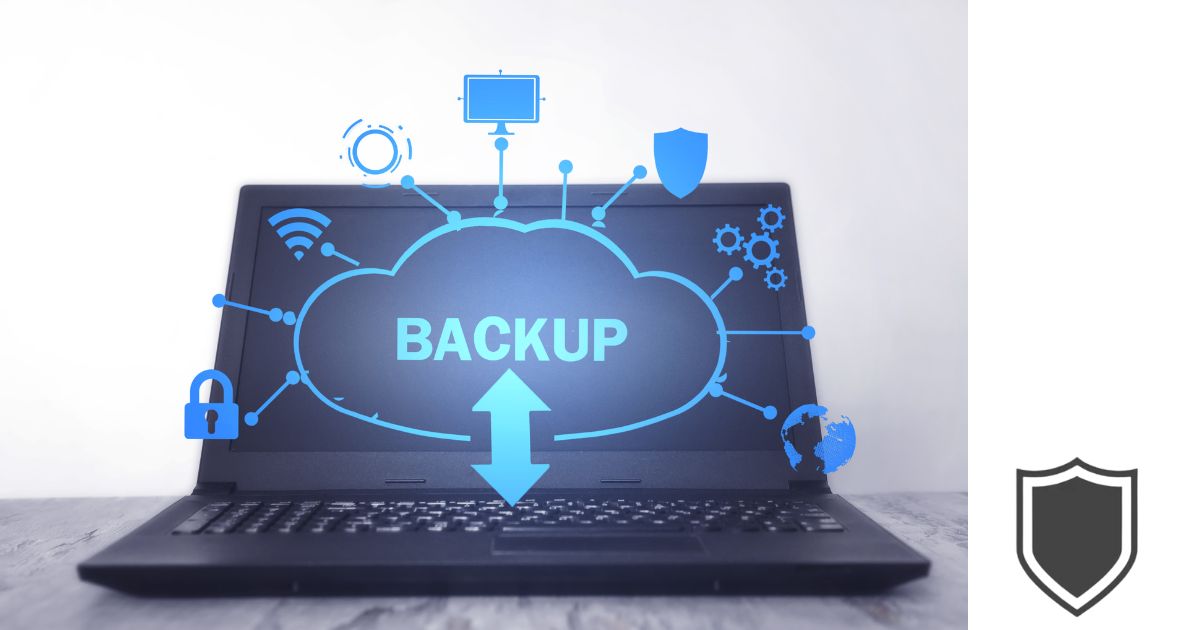Hello! Dr. Edward Baldwin here, at your service as your partner in cybersecurity. Have you ever encountered the terrifying feeling of losing important documents or photos?
It’s the kind of heart-drop moment we all dread. But fret not, my friend. In the vast digital universe, there’s a shining beacon of hope: Data Recovery and Backup Solutions.
They’re our unsung heroes, silently ensuring our digital memories and precious work documents remain intact. Let’s dive into this ultimate safety net for your digital life and make data loss a thing of the past, shall we?
Table of Contents
Understanding Data Recovery and Backup Solutions
Data backup is the process of making copies of files, while disaster recovery involves the plan and processes for using those file copies to quickly reestablish access to applications, data, and IT resources after an outage.
A good disaster recovery plan might involve switching over to a redundant set of servers and storage systems until the primary data center is back online.
In my experience, there are various types of backup solutions available, from traditional on-premises solutions to modern cloud-based ones.
Cloud backups are becoming increasingly popular, as they allow users to back up their data to hardware in a remote location, which can be accessed and managed anytime, from any device, via the internet.
Backup software like Veeam and NetApp Cloud Backup offers reliable and cost-effective backup and recovery solutions, delivering verified, granular recovery of all critical assets across different environments and applications.
These solutions help businesses and individuals ensure they have access to their data even in the event of a disaster. One of the many advantages of using these tools is that they can accelerate the backup and restore process—sometimes in just seconds.
As I see it, in the current digital landscape, it’s important that businesses and individuals take data backup and recovery seriously. Utilizing a reliable backup and recovery solution ensures data protection and minimal downtime in case of any data loss or disaster.
Significance of Data Recovery
As a tech enthusiast, I cannot stress enough the importance of data recovery in our lives. Data recovery is the process of retrieving lost, inaccessible, or damaged data from storage devices, such as hard drives, USBs, or even cloud storage.
In today’s world, where almost everything is data-driven, losing crucial information could have severe consequences for businesses, governments, and individuals alike.
Allow me to highlight a few key reasons why data recovery is vital.
Firstly, it helps to restore and save valuable information that might be lost due to accidental deletion, system failures, or physical damage to storage devices.
Think of those precious family photos, critical business documents, or essential research data. Losing these could be heartbreaking or detrimental to one’s career.
Secondly, data recovery plays a significant role in disaster recovery planning. In the unfortunate event of a natural disaster or cyber attack, having a reliable data recovery plan in place helps to reduce downtime and restore essential systems.
This allows businesses and organizations to get back on their feet quickly and minimize losses.
Lastly, data recovery is essential for upholding legal and regulatory compliance. Businesses and organizations in various industries are required to store and maintain specific data, such as financial records and customer information, for a certain period.
A solid data recovery plan ensures the organization can meet these requirements and avoid potential legal penalties.
Key Features of Backup Solutions
As I explore the world of data recovery and backup solutions, I’ve come across several key features that can greatly help in protecting and restoring our valuable data. Here are some of these essential features:
Image-level backups: One crucial aspect of backup solutions is the ability to create image-level backups of virtual, physical, and cloud-based workloads. This type of backup ensures that all data is captured in a consistent state, allowing for a seamless recovery process.
Variety of backup types: There are different types of backup techniques, such as full, incremental, and differential backups. Each of these has its own advantages and works best for specific scenarios. It’s essential to choose a backup solution that supports multiple types, allowing your organization to tailor its backup strategy to meet its unique needs.
- Full backup: The simplest and most comprehensive backup method that copies the entire data set.
- Incremental backup: Only backs up the data that has changed since the last backup, making it faster and more efficient.
- Differential backup: Backs up the data that has changed since the last full backup, striking a balance between speed and comprehensiveness.
Easy recovery: An effective backup solution should offer a straightforward and user-friendly recovery process. This includes features such as point-in-time recovery, granular file recovery, and automated recovery options to minimize downtime and ensure business continuity.
Security and encryption: Data protection doesn’t end with backing up your workloads; it’s also essential to safeguard the backup files themselves. Look for solutions that offer encryption, both during transmission and at rest, as well as protection against ransomware and other security threats.
Cross-platform compatibility: In today’s hybrid IT environments, it’s crucial to find a backup solution that can support various platforms and infrastructure types. This includes cloud, virtual, SaaS, Kubernetes, and physical environments, enabling you to protect all of your workloads, wherever they reside.
Scalability: As your organization grows, so will its data backup and recovery needs. I recommend choosing a solution that offers scalability, allowing you to adjust its capabilities as your business scales and evolves.
These are just a few of the key features to consider when selecting a data recovery and backup solution.
Different Types of Data Recovery
In my experience, there are several types of data recovery methods available to help get back your lost or corrupted data.
Let me tell you about some of the most common ones:
1. Undelete recovery: This method focuses on recovering files that have been accidentally deleted or removed from your device. It usually involves scanning the storage device for any remnants of deleted files and reassembling them to be used again.
2. Filesystem recovery: Sometimes, issues with your storage device’s filesystem can lead to loss of access to your data. In this case, data recovery software works to fix the filesystem issues and restore access to your files.
3. Partition recovery: Occasionally, entire partitions of a storage device may become inaccessible or lost due to errors, or when the partition table gets damaged. Partition recovery is a method that aims to locate and restore these lost partitions, helping you regain access to your valuable data.
4. RAID recovery: RAID systems are commonly used in businesses to provide a higher level of data redundancy and protection. However, sometimes RAID systems can fail, leading to data loss. RAID recovery involves rebuilding the RAID array and recovering the lost data.
5. Disaster recovery: For businesses, a solid disaster recovery plan is essential to protect important data in case of any catastrophic event such as natural disasters or cyber attacks. This type of recovery involves developing and implementing a comprehensive plan that outlines how data backups will be performed, stored, and restored in such circumstances.
Cost Comparison of Data Recovery and Backup Solutions

As I was researching various data recovery and backup solutions, I discovered that the cost of these services can vary greatly depending on the specific software you choose.
There are many providers out there offering a range of features at different price points. In this section, I’ll briefly discuss some of the popular options and their respective costs.
One common data recovery software is EaseUS Data Recovery Wizard. It’s available for both Windows and macOS platforms. This software comes in a freemium version, which means you can try it for free, but to unlock its full potential, you’ll need to shell out anywhere between $0.00 and $69.95 per month.
Another popular option is Recoverit. Like EaseUS, it’s also compatible with Windows and macOS and offers a freemium model. The prices for Recoverit range from $0.00 to $59.99 per month.
When it comes to backup solutions, some popular choices include IDrive, ShadowProtect SPX Desktop by StorageCraft, and Acronis Cyber Protect. These platforms provide excellent value and dependability.
Here’s a quick comparison of their prices:
- IDrive: Offers a Personal Plan at around $52.12/year for 2TB of storage or a Business Plan starting at $74.62/year for 250GB of storage;
- ShadowProtect SPX Desktop: Pricing available upon request, but they usually offer competitive rates with a focus on corporate clients;
- Acronis Cyber Protect: Offers three plans, ranging from $49.99/year for 250GB of storage to $99.99/year for 5TB of storage.
While having affordable options is great, it’s important to consider that the specific features offered by each software might be different. So, while comparing costs, make sure to also factor in the necessary functionalities for your needs.
Remember, investing in a good backup and data recovery solution is crucial for protecting valuable information. Taking the time to find the right software that fits your budget and demands will ensure that you’re well-prepared in case of data loss or other technical issues.
Data Recovery and Backup Solutions for Businesses

As a business owner, I realize how crucial it is to have reliable data recovery and backup solutions in place. Losing important data can have severe consequences for any company, from financial loss to damaged reputation.
In this era of digital transformation, there are several options to ensure data protection and recovery to keep our businesses safe and secure against any unforeseen circumstances.
A couple of standouts in the market are Veeam and Cohesity.
Veeam is well-known for its modern data protection capabilities, offering flexibility for today’s hybrid cloud environments, and providing peace of mind for long-term success. They ensure data resiliency through secure data backup, fast and reliable recovery, and protection solutions for cloud, virtual, and physical environments.
Their approach to data recovery is comprehensive and flexible. With Veeam, instant restoration is available for anything needed, ranging from targeted attacks to accidental deletion, across any platform, be it cloud, physical, virtual, or SaaS. The coverage offered by Veeam is wide, encompassing both large-scale recovery and granular levels of data protection.
Another excellent option is Cohesity, also recognized as a leader in enterprise backup and recovery software solutions. Their single, scalable platform is known for its consistency and effectiveness in performing backups. With their DataLock feature, businesses can rest easy knowing that their data is secure from corruption by ransomware attacks.
Options like Carbonite’s Safe product line offer backup capabilities for desktops, laptops, and servers. This includes remote file access, making it a well-rounded choice for a variety of businesses. It is important to research and choose a backup and recovery solution that aligns well with the specific needs and requirements of our individual organizations.
Data Recovery and Backup Solutions for Personal Use

As someone who cherishes my digital data, I’ve looked into some fantastic data recovery and backup solutions to keep my personal files safe.
Firstly, let me tell you about Veeam. Veeam offers a modern data protection platform that focuses on data recovery, security, and freedom. It makes sure that our precious data is recovered quickly, securely, and reliably. It’s perfect for those who want a versatile solution for their personal use.
Now, moving on, I recently stumbled upon a list by TechRadar featuring the best backup software of 2023.
I found that some of the backup software mentioned in the list are quite user-friendly and efficient, ensuring that our critical files are backed up with minimal effort. It’s definitely worth checking out if you’re exploring options for personal use.
- The same source, TechRadar, also shared a list of the best data recovery software of 2023. Many of these solutions are beginner-friendly and highly efficient in recovering lost or deleted files, which can come in handy when we encounter unexpected data loss.
On the other hand, PCMag recommends some great backup software and services that are perfect for both computers and mobile devices. They’ve carefully analyzed various services and chosen the best ones to keep our devices protected from data loss.
Choosing the Right Data Recovery and Backup Solution
When it comes to picking the right data recovery and backup solution, some key aspects that should be taken into account include recovery functionalities, customer service quality, and the vendor’s reputation.
I always look for recovery functionalities when choosing a backup solution, as it’s crucial to make sure that your data can be restored effectively and timely.
Make sure to pick a solution that supports incremental backups and offers the ability to restore individual files. Also, pay attention to how the solution handles system crashes, ransomware attacks, and accidental deletions.
Customer support is another critical area to focus on; after all, when dealing with data recovery, having reliable and knowledgeable support is essential.
Try to find a solution with 24/7 customer service, and if possible, one that offers live chat or phone support. This way, you can be sure to receive prompt assistance whenever you need it.
The reputation of the vendor is equally important when selecting a data recovery and backup solution. I would recommend checking out user reviews and testimonials, with a focus on aspects such as ease of use, reliability, and scalability. Don’t hesitate to ask for recommendations in your professional network or on social media platforms.
Lastly, consider the pricing and your budget – try to find a solution that offers a good balance between features and affordability. Some solutions offer free trials or limited free versions, which can be a great way to test the solution before committing to a purchase.
Maintenance of Data Recovery and Backup Solutions
I’ve learned that maintaining data recovery and backup solutions is essential for protecting valuable information stored in our devices. Let me share some key points to consider when managing backup maintenance.
First, it’s important to regularly test the backup and recovery process. This ensures that, in case of data loss, we can efficiently recover files and resume business operations without significant delays. Testing can be done in various forms, like simulating a data loss event or performing a trial restoration.
Another crucial aspect is keeping backup software up-to-date. Software developers constantly release updates and patches to improve their products. Staying current on these updates can help enhance system security and maintain compatibility with evolving technologies.
We must also remember to maintain a secure storage location for backup files. Encryption and access controls are necessary to protect our data from unauthorized access. This is especially important when using cloud-based services, as data will be stored offsite and accessed over the internet.
Next, it’s essential to monitor storage capacity and allocate resources accordingly. As the amount of data grows, we might need to consider expansion or data deduplication techniques. Regularly reviewing storage requirements helps to ensure a smooth recovery process and avoid potential problems.
Lastly, it’s a good idea to have a sound retention policy in place. This means defining how long backup copies should be stored before being purged or overwritten. Retention policies must balance the need for data recovery with legal or regulatory obligations and the cost of storage.
Shortcomings of Data Recovery and Backup Solutions
In my experience, I have noticed some shortcomings in data recovery and backup solutions that are worth considering.
Firstly, compatibility issues may arise when using different backup software and hardware solutions. Different vendors have unique proprietary file formats to store backed-up data, which can lead to issues when trying to restore data using a different software or hardware. So, it’s essential to choose a backup solution that provides broader compatibility.
Additionally, some data recovery and backup solutions may have limited scalability. As a company grows and its data needs increase, the backup infrastructure should also expand. However, certain solutions might not offer easy or cost-efficient scaling, which could hinder business growth.
Another potential shortcoming is data recovery time. Depending on the backup solution, it could take longer than desirable to recover data in the event of a disaster. Speedy recovery times are critical to minimize downtime and ensure business continuity.
Moreover, some backup solutions may have incomplete coverage of files and applications. It’s vital to select a software that backs up all necessary files and applications, preventing data loss in case of an incident.
Lastly, security risks could be an issue. While most data recovery and backup providers take security seriously, there can still be vulnerabilities that can lead to data breaches, especially if data is stored in the cloud. It’s crucial to choose a provider with a solid security track record and robust encryption methods.
Future of Data Recovery and Backup Solutions
As I look into the future of data recovery and backup solutions, I see a few trends emerging that are worth mentioning.
One of these trends is the increasing popularity of multi-cloud data backup and recovery. Multi-cloud strategies offer flexibility and performance optimization by mixing and matching services across different providers. As these strategies expand, so does the need for multi-cloud backup and recovery solutions.
Another aspect of the future of data recovery is the technologies driving data creation, consumption, and storage. For example, big data systems will require data recovery solutions that can handle large amounts of information and support a wide range of file formats. Additionally, upcoming data storage techniques such as Helium drives will also influence data recovery advancements.
Now, let’s talk about Backup as a Service (BaaS). BaaS has gained traction in recent years and provides complete data protection for VMware, Hyper-V, and physical systems. As we move forward, adopting BaaS for both on-premise and cloud environments will become more prevalent among businesses.
In 2023 and beyond, we can also expect improved backup and disaster recovery (DR) solutions that can handle both increasing data and security risks. These solutions will become more capable of meeting emerging needs, but choosing the right one will depend on various factors, such as the size of your business, your IT infrastructure, and specific data protection requirements.
Finally, fast and secure data recovery is crucial for businesses in the future. With a focus on multi-layered protection, modern data recovery solutions will prioritize both speed and security, ensuring that data can be recovered whenever and wherever needed.
The Final Word
Alright, folks, it’s wrap-up time. Dr. Edward Baldwin here, signing off. If there’s one thing you take away from our journey through data recovery and backup solutions, let it be this: always have a plan B.
Our digital realms are vast, and things can go haywire, but with the right tools in your arsenal, you’re pretty much invincible. So, keep those files safe, have that backup ready, and sleep a tad sounder knowing you’re covered.
Until next time, stay savvy and secure out there! Cheers!
Data Recovery and Backup Solutions FAQs
What are the top on-premise and cloud backup solutions?
In my experience, some of the top on-premise backup solutions include Veeam Backup & Replication, Acronis Cyber Backup, and Veritas Backup Exec. For cloud backup solutions, popular options are Datto, Carbonite, and MSP360. Of course, the right solution for you will depend on your organization’s specific needs and requirements.
How to choose the best enterprise backup software?
When choosing the best enterprise backup software, it’s important to consider factors like ease of use, security measures, scalability, compatibility with your IT infrastructure, and cost. Look for software that offers both on-premise and cloud-based backup options to ensure flexibility in your data protection strategy.
What is the difference between SaaS and network backup solutions?
The main difference between Software as a Service (SaaS) and network backup solutions is where the backup data is stored. SaaS backup solutions typically store data in the cloud, while network backup solutions store the data on physical hardware, like servers, within your organization’s network. SaaS solutions offer easy scalability and remote access, while network backup solutions usually provide greater control over the backup process.
What features to look for in a data recovery and backup solution?
When evaluating data recovery and backup solutions, it’s crucial to look for features like broad platform support, fast recovery times, centralized management, automation capabilities, and strong security measures. Also, double-check whether the software provides both file-level and image-level backup options so that you can protect different types of data.
How does Veeam Backup compare to other backup software?
Veeam Backup is a popular choice due to its powerful features, ease of use, and comprehensive data protection capabilities. It outshines many competitors with its fast recovery times, centralized management, and support for both virtual and physical environments. While some other backup software may offer similar functionality, Veeam’s robust feature set and strong reputation make it an essential option to consider.
Are there any free backup and recovery software options?
Yes! Several free backup and recovery software options are available, suitable for smaller businesses or personal use. Some of the popular free backup tools include EaseUS Todo Backup Free, Paragon Backup & Recovery, and AOMEI Backupper Standard. Keep in mind that these free solutions may lack some advanced features and support provided by paid enterprise solutions.
- Data Recovery and Backup Solutions: Your Ultimate Safety Net - May 2, 2025
- Is ChatGPT Private? Unraveling the Facts and Concerns - May 2, 2025
- Soaked to Saved: The Art of Water Damage Data Recovery - May 2, 2025











2 thoughts on “Data Recovery and Backup Solutions: Your Ultimate Safety Net”